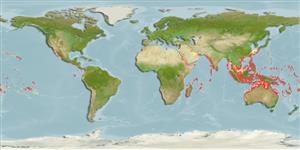Klassifizierung / Names
Namen | Synonyme | Catalog of Fishes(Gattung, Arten) | ITIS | CoL | WoRMS | Cloffa
>
Lophiiformes (Anglerfishes) >
Antennariidae (Frogfishes)
Etymology: Antennarius: From Latin, antenna, antemna = sensory organ (Ref. 45335).
Eponymy: Dr Philibert Commerson (1727–1773) was known as ‘doctor, botanist and naturalist of the King’. [...] (Ref. 128868), visit book page.
More on author: Lacepède.
Environment: milieu / climate zone / depth range / distribution range
Ökologie
seewasser riff-verbunden; tiefenbereich 0 - 70 m (Ref. 89972), usually ? - 20 m (Ref. 9269). Tropical; 32°N - 32°S
Indo-Pacific and Eastern Pacific: Red Sea and South Africa (Ref. 4113) to Panama, north to southern Japan and the Hawaiian Islands, south to the Lord Howe and the Society islands. Referred to as Antennarius moluccensis by authors.
Size / Gewicht / Alter
Maturity: Lm ? range ? - ? cm
Max length : 45.0 cm TL Männchen/unbestimmt; (Ref. 90102)
Rückenflossenstacheln (insgesamt) : 3; Rückenflossenweichstrahlen (insgesamt) : 12 - 13; Afterflossenstacheln: 0; Afterflossenweichstrahlen: 8. Comes in a variety of colors: yellow, orange, green, brown, and black. Bony part of illicium about equal to length of the 2nd dorsal spine (10.2-16.9 %SL); esca a small tuft of flattened appendages (Ref. 4538). Illicial length in %SL: 19.3-25.2 (Ref. 6773). Membrane behind 2nd dorsal spine thick and spinulose, extending to base of third (Ref. 6773). One of the largest species (Ref. 48635).
Found in lagoon and seaward reefs (Ref. 9710), often on jetty (Ref. 48635). Benthic (Ref. 58302). Feed on fish (Ref. 11889) and small shrimps (Ref. 89972). Oviparous. Eggs are bound in ribbon-like sheath or mass of gelatinous mucus called 'egg raft' or 'veil' (Ref. 6773). Solitary and frequently among sponges in 1-50 m, usually less than 20 m (Ref 90102).
Life cycle and mating behavior
Geschlechtsreife | Fortpflanzung | Ablaichen | Eier | Fecundity | Larven
Oviparous. Eggs are bound in ribbon-like sheath or mass of gelatinous mucus called 'egg raft' or 'veil' (Ref. 6773).
Pietsch, T.W. and D.B. Grobecker, 1987. Frogfishes of the world. Systematics, zoogeography, and behavioral ecology. Stanford University Press, Stanford, California. 420 p. (Ref. 6773)
IUCN Rote Liste Status (Ref. 130435: Version 2024-2)
Bedrohung für Menschen
Harmless
Nutzung durch Menschen
Fischereien: nicht kommerziell
Tools
Zusatzinformationen
Download XML
Internet Quellen
Estimates based on models
Preferred temperature (Ref.
123201): 24.5 - 29, mean 27.9 °C (based on 652 cells).
Phylogenetic diversity index (Ref.
82804): PD
50 = 0.5005 [Uniqueness, from 0.5 = low to 2.0 = high].
Bayesian length-weight: a=0.02630 (0.01029 - 0.06725), b=2.96 (2.73 - 3.19), in cm total length, based on LWR estimates for this (Sub)family-body shape (Ref.
93245).
Trophic level (Ref.
69278): 4.2 ±0.73 se; based on food items.
Widerstandsfähigkeit (Ref.
120179): hoch, Verdopplung der Population dauert weniger als 15 Monate. (Fec assumed to be > 10,000).
Fishing Vulnerability (Ref.
59153): Low to moderate vulnerability (35 of 100).
Nutrients (Ref.
124155): Calcium = 35.3 [17.9, 59.7] mg/100g; Iron = 0.568 [0.304, 0.993] mg/100g; Protein = 19 [17, 22] %; Omega3 = 0.105 [0.040, 0.254] g/100g; Selenium = 34.5 [16.4, 78.0] μg/100g; VitaminA = 101 [26, 373] μg/100g; Zinc = 0.82 [0.53, 1.24] mg/100g (wet weight);
